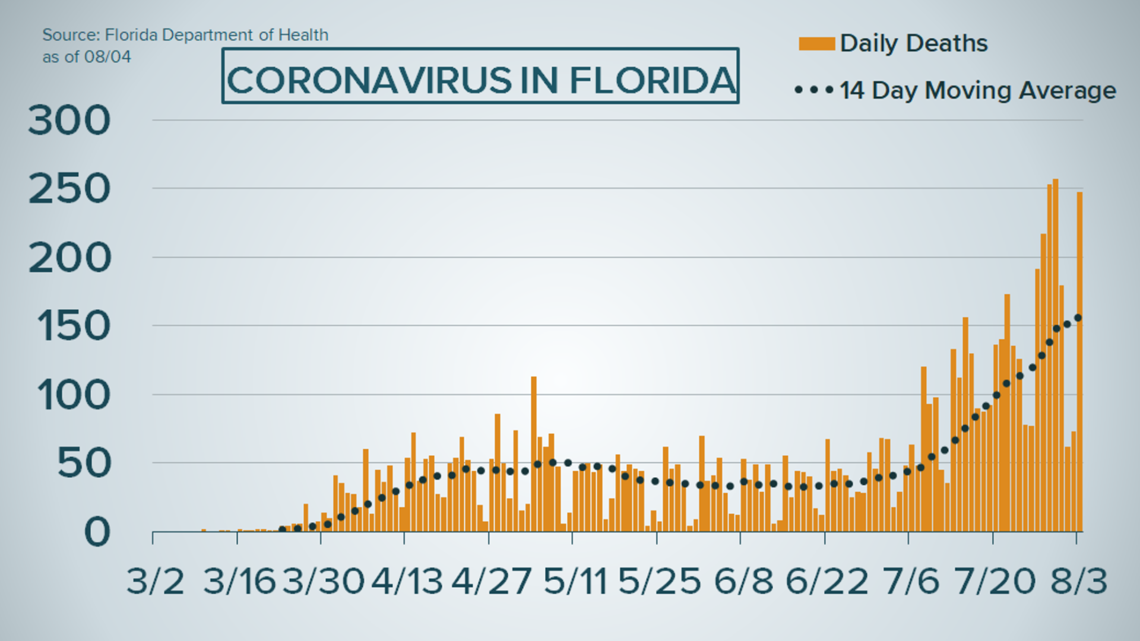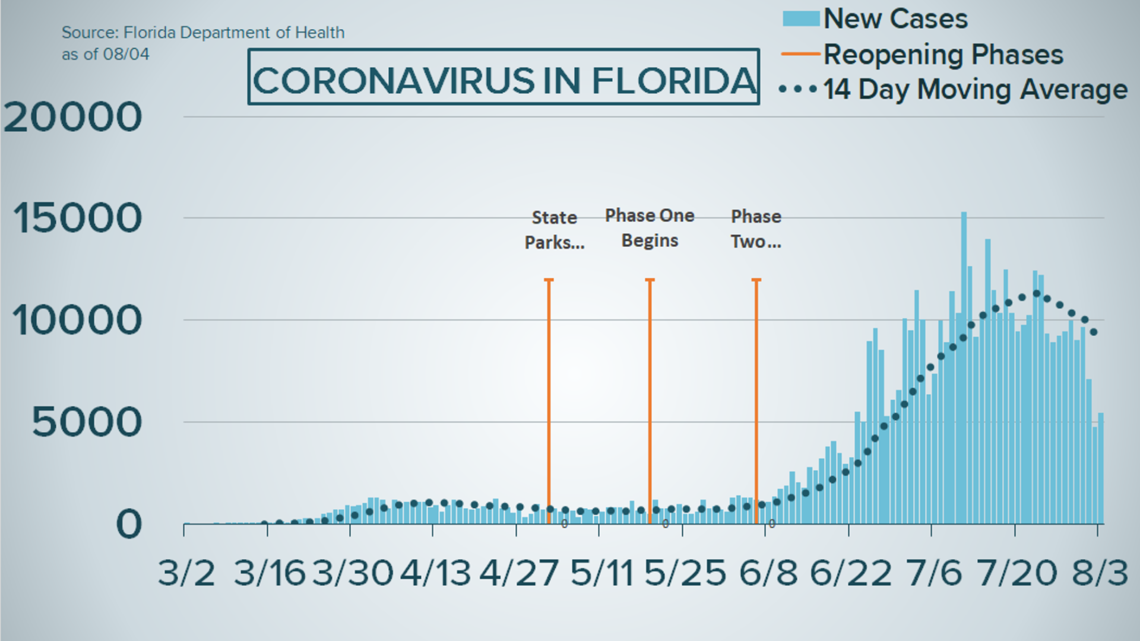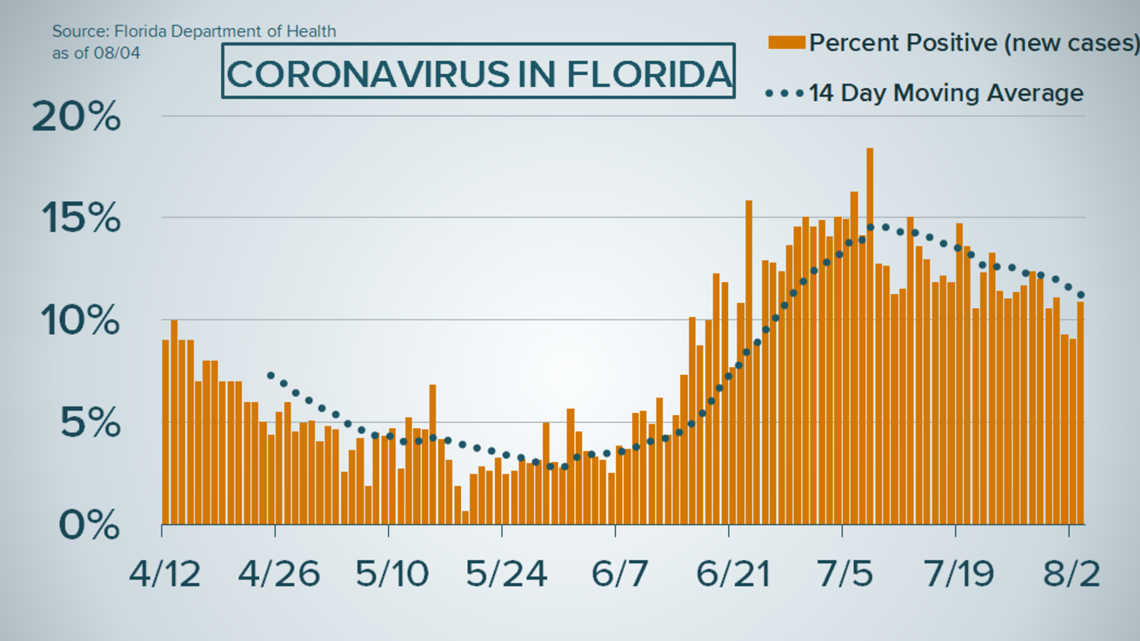In Tuesday's report from the Florida Department of Health, the state recorded another 5,446 new COVID-19 cases for Aug. 3.
That brings the total number of coronavirus cases statewide to 497,330 since March.
The median age of Floridians testing positive as of Tuesday morning is 42, which has been the average for the last five days.
The DOH also reported another 245 Floridians and two non-residents had died after testing positive for coronavirus. That brings the total to 7,402 Floridians and 124 non-residents since the pandemic began.
That does not necessarily mean all those people died on August 3, but rather the state learned of their deaths and added the numbers to the report that day. The state's daily line-by-line report, which you can read here, lists coronavirus deaths by the date the people tested positive for the virus, not the date they passed.
In contrast, our chart below shows deaths by the date on which they were added to Florida's report.
The report released on Friday of 257 newly confirmed deaths was the highest reported by the state in a single day's report. Florida reported 3,588 new deaths (Floridians and non-residents) just in July. That is more than 50 percent of the total number of deaths reported by the state.
When it comes to testing, Tuesday's report showed 56,533 test results were turned in from labs on Aug. 3. Of those tests, 10.88 percent were positive for the virus.
It's important to note, testing sites on Florida's east coast were closed Thursday evening through Sunday ahead of impacts of Tropical Storm Isaias. Those sites reopened Monday morning.
As for hospitalizations, 7,729 people were hospitalized with COVID-19 as their primary diagnosis as of 10:30 a.m. Tuesday. And, 1,477 of them are in the Tampa Bay area.
A total of 27,952 people in Florida have been hospitalized at some point during the pandemic.


Here's a breakdown of the new coronavirus cases reported to the state:
- June 21: 2,926
- June 22: 3,286
- June 23: 5,508
- June 24: 5,004
- June 25: 8,942
- June 26: 9,585
- June 27: 8,530
- June 28: 5,266
- June 29: 6,093
- June 30: 6,563
- July 1: 10,109
- July 2: 9,488
- July 3: 11,458
- July 4: 10,059
- July 5: 6,336
- July 6: 7,347
- July 7: 9,989
- July 8: 8,935
- July 9: 11,433
- July 10: 10,360
- July 11: 15,300
- July 12: 12,624
- July 13: 9,194
- July 14: 10,181
- July 15: 13,965
- July 16: 11,466
- July 17: 10,328
- July 18: 12,478
- July 19: 10,347
- July 20: 9,440
- July 21: 9,785
- July 22: 10,249
- July 23: 12,444
- July 24: 12,199
- July 25: 9,344
- July 26: 8,892
- July 27: 9,230
- July 28: 9,446
- July 29: 9,956
- July 30: 8,989
- July 31: 9,643
- August 1: 7,104
- August 2: 4,752
- August 3: 5,446


Breaking down the numbers
There wasn't a single day during the entire month of July where the number of newly-confirmed cases was fewer than 6,000. In fact, the last time that happened was on June 28.
The highest single-day case number Florida has reported so far is 15,300 for July 11.
The World Health Organization and infectious disease experts around the globe have recommended a positivity rate of 5 percent or lower for a 14-day span in order to be comfortable reopening.
Florida has not seen a positivity rate at 5 percent since the beginning of June. For more than a month, the state has reported positivity rates at double and even triple that recommended percentage.
Sunday's and Monday's reports for Aug. 1 and 2, respectively, showed positivity rates below 10 percent for the first time since June 24.
Florida remains in Phase Two of reopening, which began June 5.


Hospitalizations and ICU bed availability
Cases are climbing, but what about hospitalizations?
Tracking hospitalizations got easier on July 10 when the Agency for Health Care Administration began publishing a spreadsheet with the number of people currently checked-in for coronavirus-related complications in Florida. The data only includes people whose "primary diagnosis" was COVID-19.
As of 10:30 a.m. Tuesday, 7,729 people were hospitalized with COVID-19 as their primary diagnosis statewide, and 1,477 of them were in the Tampa Bay area. Those numbers are frequently updated, and you can click here for the most recent data, which is also broken down by county.
Since the pandemic began, the state confirms a total of 27,952 residents were hospitalized at some point during their illness.
The Agency for Healthcare Administration (AHCA) also updates total hospital bed and ICU availability by county.
Click here for a breakdown of adult and pediatric ICU bed availability by county. You can also check ICU availability by the hospital.
Hospitalizations around Tampa Bay and total staffed hospital bed capacity status:
**Data as of 10:15 a.m. on August 4
Citrus:
- 24 COVID-19 hospitalizations
- 57 of 296 total staffed hospital beds are available
DeSoto:
- 4 COVID-19 hospitalizations
- 21 of 55 total staffed hospital beds are available
Hardee:
- 0 COVID-19 hospitalizations
- 1 of 25 total staffed hospital beds are available
Hernando:
- 55 COVID-19 hospitalizations
- 202 of 722 total staffed hospital beds are available
Highlands:
- 58 COVID-19 hospitalizations
- 48 of 267 total staffed hospital beds are available
Hillsborough:
- 466 COVID-19 hospitalizations
- 589 of 3,871 total staffed hospital beds are available
Manatee:
- 95 COVID-19 hospitalizations
- 93 of 771 total staffed hospital beds are available
Pasco:
- 92 COVID-19 hospitalizations
- 276 of 1,396 total staffed hospital beds are available
Pinellas:
- 326 COVID-19 hospitalizations
- 555 of 2,910 total staffed hospital beds are available
Polk:
- 256 COVID-19 hospitalizations
- 374 of 1,654 total staffed hospital beds are available
Sarasota:
- 101 COVID-19 hospitalizations
- 213 of 1,219 total staffed hospital beds are available

